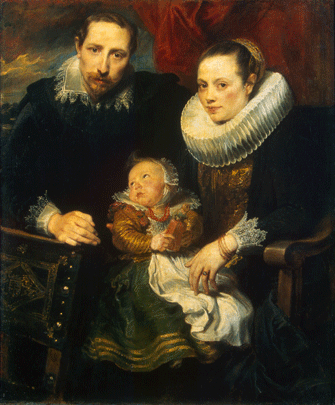Gentleman Painter
 |
| “Portrait of a Family” (c. 1620). © Hermitage National Museum/Vladimir Terebenin, Leonard Kheifets, Yuri Molodkovets, Svetlana Suetova |
Anyone who thinks portrait paintings are boring should rush to see the new Van Dyck exhibition at the Musée Jacquemart-André. Although he lived to be only just past the age of 40, Anthony Van Dyck (1599-1641) produced a stunning body of work whose genius comes through clearly in this show of his portraits.
Van Dyck the prodigy was producing brilliant, lively portraits with a personal touch when still an adolescent. The exhibition starts with several fine examples. In a double portrait of a couple (1618-19), for instance, the husband leans away from his intelligent-looking wife yet holds her hand affectionately. Even confined in their stiff ruffs, they seem very human and alive. Van Dyck introduces movement into a portrait of a family (c. 1620; pictured above) by having the baby in the center twist around to look up at its father, who leans forward dynamically while his wife gazes placidly at the artist.
This dynamism also characterizes the dashing self-portrait painted in 1622 or ‘23 in which he depicts himself as the “gentleman painter” he aspired to be. With his long, curly hair; tapering fingers; casual pose; and bags under his eyes, he looks more like a young rake than an accomplished artist. A dandy before his time, Van Dyck liked to show off his aristocratic manners, retinue of servants and luxurious attire. He never stopped working, however, and although he made his name and fortune as a painter of royals and aristocrats, he didn’t forget his artist and intellectual friends, whom he ennobled as “aristocrats” of virtù in his portraits.
Born in Antwerp and trained by Rubens, Van Dyck worked in the tradition of the Flemish masters – witness the gorgeous detailing of lace, gold and fabrics – but was strongly influenced by the Italian Renaissance painters, notably Titian, his predecessor as a virtuoso portraitist, and Raphael.
The favorite of the Genovese upper classes between 1621 and ‘27, Van Dyck later became the darling of the English court, where he painted appropriately serious yet animated portraits of royals and aristocrats, enlivened by sumptuous details of lavish clothing and accoutrements. The portrait of Charles I in the exhibition, in spite of the formal pose and royal trappings, still manages to communicate something of the king’s personality.
This gem of an exhibition includes a dozen or so drawings, among them a handsome study for a portrait of Cardinal Guido Bentivoglio and a lively portrait of Charles I.
Musée Jacquemart-André: 158, boulevard Haussmann, 75008 Paris. Métro: Saint Augustin. Tel.: 01 45 62 11 59. Open daily, 10 a.m.-6 p.m. Through January 25. www.musee-jacquemart-andre.com
© 2008 Paris Update
More reviews of current art exhibitions.
Reader Reaction
Click here to respond to this article (your response may be published on this page and is subject to editing).
